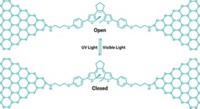Advertisement
Grab your lab coat. Let's get started
Welcome!
Welcome!
Create an account below to get 6 C&EN articles per month, receive newsletters and more - all free.
It seems this is your first time logging in online. Please enter the following information to continue.
As an ACS member you automatically get access to this site. All we need is few more details to create your reading experience.
Not you? Sign in with a different account.
Not you? Sign in with a different account.
ERROR 1
ERROR 1
ERROR 2
ERROR 2
ERROR 2
ERROR 2
ERROR 2
Password and Confirm password must match.
If you have an ACS member number, please enter it here so we can link this account to your membership. (optional)
ERROR 2
ACS values your privacy. By submitting your information, you are gaining access to C&EN and subscribing to our weekly newsletter. We use the information you provide to make your reading experience better, and we will never sell your data to third party members.
Materials
Getting that organic glow
Chemists design and synthesize organic molecules that phosphoresce at room temperature
by Bethany Halford
October 17, 2016
| A version of this story appeared in
Volume 94, Issue 41
Phosphorescent materials, which continue to glow even after the light that put them into an excited state has been removed, have applications in electronics, optics, and biology. But achieving phosphorescence at room temperature and in the presence of oxygen can be tough because the excited state of such molecules is sensitive to these conditions. To date, most compounds that exhibit room-temperature phosphorescence contain metals, making them more costly and potentially toxic. Chemists in China now report a series of five organic molecules that efficiently and persistently phosphoresce in a range of colors in air and at room temperature (Chem 2016, DOI: 10.1016/j.chempr.2016.08.010). The team, led by Ben Zhong Tang of Hong Kong University of Science & Technology and Qian Peng of the Institute of Chemistry, Chinese Academy of Sciences, designed the aromatic carbonyl compounds so that their excited states have a tunable configuration that promotes phosphorescence. The most promising compound, 1-(dibenzo[b,d]furan-2-yl)phenylmethanone, or BDBF, has a phosphorescence lifetime of 230 milliseconds and an efficiency of 34.5%. The researchers hope the design guidelines they developed will lead to even better organic phosphors.
![A pile of 1-(dibenzo[b,d]furan-2-yl)phenylmethanone, or BDBF, powder shown during excitation. A pile of 1-(dibenzo[b,d]furan-2-yl)phenylmethanone, or BDBF, powder shown during excitation.](https://s7d1.scene7.com/is/image/CENODS/09441-scicon-excitation?$responsive$&wid=700&qlt=90,0&resMode=sharp2)




Join the conversation
Contact the reporter
Submit a Letter to the Editor for publication
Engage with us on Twitter